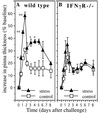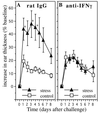Stress-induced enhancement of skin immune function: A role for gamma interferon
- PMID: 10706626
- PMCID: PMC16018
- DOI: 10.1073/pnas.050569397
Stress-induced enhancement of skin immune function: A role for gamma interferon
Abstract
Contrary to the widespread belief that stress is necessarily immunosuppressive, recent studies have shown that, under certain conditions, stress can induce a significant enhancement of a skin cell-mediated immune response [delayed-type hypersensitivity (DTH) or contact hypersensitivity]. Adrenal stress hormones and a stress-induced trafficking of leukocytes from the blood to the skin have been identified as systemic mediators of this immunoenhancement. Because gamma interferon (IFNgamma) is an important cytokine mediator of DTH, the studies described here were designed to examine its role as a local mediator of the stress-induced enhancement of skin DTH. The effect of acute stress on skin DTH was examined in wild-type and IFNgamma receptor-deficient (IFNgammaR-/-) mice that had previously been sensitized with 2,4-dinitro-1-fluorobenzene. Acutely stressed wild-type mice showed a significantly larger DTH response than nonstressed mice. In contrast, IFNgammaR-/- mice failed to show a stress-induced enhancement of skin DTH. Immunoneutralization of IFNgamma in wild-type mice significantly reduced the stress-induced enhancement of skin DTH. In addition, an inflammatory response induced by direct IFNgamma administration to the skin was significantly enhanced by acute stress. Our results suggest that IFNgamma is an important local mediator of a stress-induced enhancement of skin DTH. These studies are clinically relevant because, depending on the nature of the antigen, DTH reactions mediate numerous protective (e.g., resistance to viral, bacterial, parasitic, and fungal infections) or pathological (e.g., autoimmune reactions and contact sensitivity reactions such as that to poison ivy) immune responses.
Figures





Similar articles
-
Acute stress enhances while chronic stress suppresses cell-mediated immunity in vivo: a potential role for leukocyte trafficking.Brain Behav Immun. 1997 Dec;11(4):286-306. doi: 10.1006/brbi.1997.0508. Brain Behav Immun. 1997. PMID: 9512816
-
Acute stress enhances while chronic stress suppresses skin immunity. The role of stress hormones and leukocyte trafficking.Ann N Y Acad Sci. 2000;917:876-93. doi: 10.1111/j.1749-6632.2000.tb05454.x. Ann N Y Acad Sci. 2000. PMID: 11268419 Review.
-
Stress, leukocyte trafficking, and the augmentation of skin immune function.Ann N Y Acad Sci. 2003 May;992:205-17. doi: 10.1111/j.1749-6632.2003.tb03151.x. Ann N Y Acad Sci. 2003. PMID: 12794060 Review.
-
The paradoxical effects of lead in interferon-gamma knockout BALB/c mice.Toxicol Sci. 2006 Feb;89(2):444-53. doi: 10.1093/toxsci/kfj043. Epub 2005 Nov 9. Toxicol Sci. 2006. PMID: 16280381
-
Glutathione depletion inhibits dendritic cell maturation and delayed-type hypersensitivity: implications for systemic disease and immunosenescence.J Allergy Clin Immunol. 2007 May;119(5):1225-33. doi: 10.1016/j.jaci.2007.01.016. Epub 2007 Mar 1. J Allergy Clin Immunol. 2007. PMID: 17335885
Cited by
-
Short day lengths augment stress-induced leukocyte trafficking and stress-induced enhancement of skin immune function.Proc Natl Acad Sci U S A. 2002 Mar 19;99(6):4067-72. doi: 10.1073/pnas.062001899. Proc Natl Acad Sci U S A. 2002. PMID: 11904451 Free PMC article.
-
Pineal-dependent and -independent effects of photoperiod on immune function in Siberian hamsters (Phodopus sungorus).Horm Behav. 2007 Jan;51(1):31-9. doi: 10.1016/j.yhbeh.2006.08.001. Epub 2006 Oct 4. Horm Behav. 2007. PMID: 17022983 Free PMC article.
-
The short-term stress response - Mother nature's mechanism for enhancing protection and performance under conditions of threat, challenge, and opportunity.Front Neuroendocrinol. 2018 Apr;49:175-192. doi: 10.1016/j.yfrne.2018.03.004. Epub 2018 Mar 26. Front Neuroendocrinol. 2018. PMID: 29596867 Free PMC article. Review.
-
Critical role for the chemokine receptor CXCR6 in NK cell-mediated antigen-specific memory of haptens and viruses.Nat Immunol. 2010 Dec;11(12):1127-35. doi: 10.1038/ni.1953. Epub 2010 Oct 24. Nat Immunol. 2010. PMID: 20972432 Free PMC article.
-
The impact of psychosocial stress and stress management on immune responses in patients with cancer.Cancer. 2019 May 1;125(9):1417-1431. doi: 10.1002/cncr.31943. Epub 2019 Feb 15. Cancer. 2019. PMID: 30768779 Free PMC article. Review.
References
Publication types
MeSH terms
Substances
LinkOut - more resources
Full Text Sources

